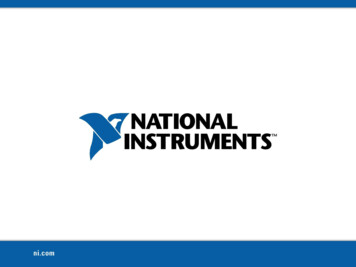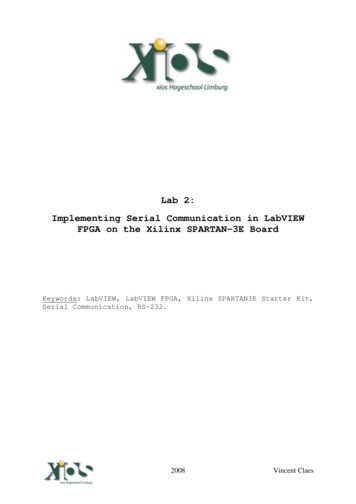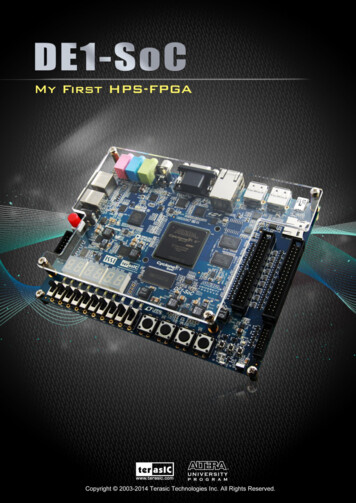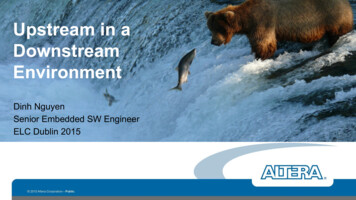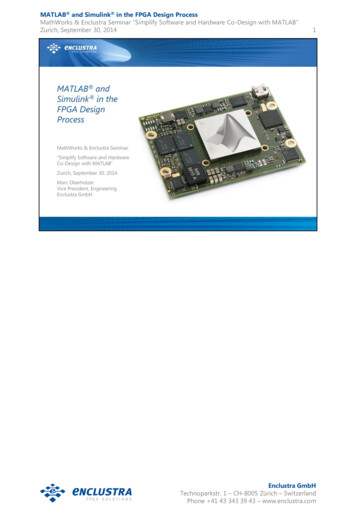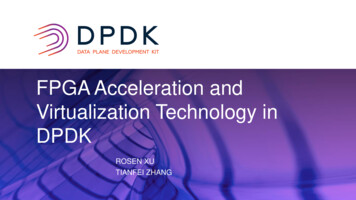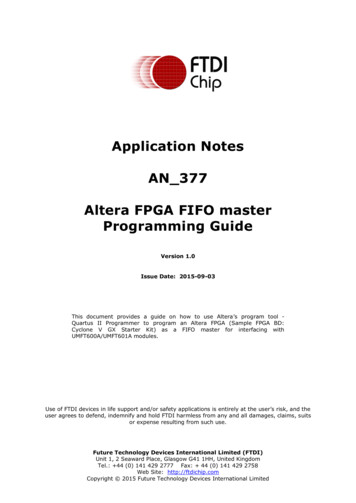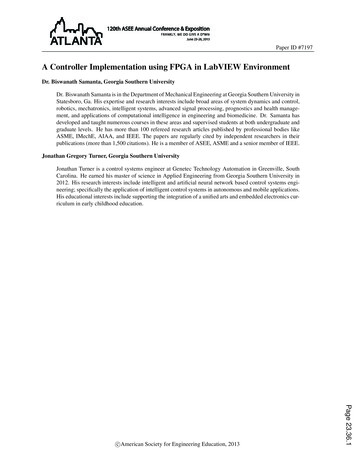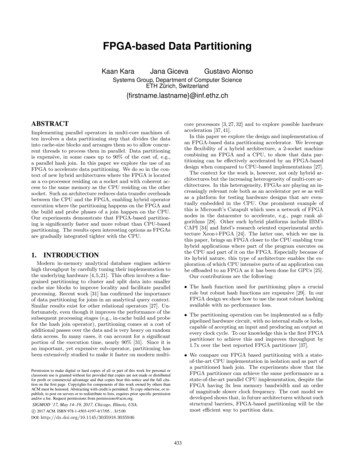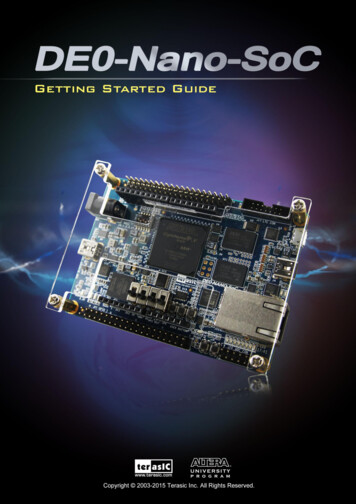
Transcription
FPGA-forum 2016The 11th FPGA-forum – where the Norwegian FPGA community meets- FPGA-forum and exhibition: Wednesday 10 and Thursday 11 February 2016- Tutorials/Workshops:Tuesday 9 February 2016Britannia Hotel (Trondheim)FPGA-forum er den årlige møteplassen for FPGA-miljøet i Norge. Her samles FPGAdesignere, prosjektledere, tekniske ledere, forskere, siste års studenter og de størsteleverandørene på ett sted for 2 dagers praktisk fokus på FPGA.Det blir foredrag fra norske bedrifter om utviklingsmetodikk og praktisk erfaring,universitetene presenterer nye og spennende prosjekter, og leverandørene stiller medaktuelle tekniske innlegg med et minimum av markedsføring. På utstillingen vil dukunne vurdere teknologi og verktøy fra de ledende leverandørene i bransjen.FPGA-forum byr i tillegg på en ypperlig anledning til å møtes og utveksle erfaringinnenfor FPGA-miljøet i Norge - både i pausene og under det sosiale arrangementet påkvelden.In English:FPGA-forum is a yearly event for the Norwegian FPGA community. FPGA-designers, projectmanagers, technical managers, researchers, final year students and the major vendors gatherfor a two-day focus on FPGA.There will be presentations from the Norwegian industry about methodology and practicalexperience, - the universities will present new and exciting projects, and the vendors will havetechnical presentations with a minimum of marketing. At the exhibition, you can evaluate toolsand technology from the leading vendors.FPGA-forum also provides an excellent opportunity to meet and exchange experience with theNorwegian FPGA-community – during the breaks – and during the official dinner party onWednesday.
Programme Wednesday, February 10, 2016(See appendix for abstracts and presentation language)09.00Registration and coffee09.25OpeningSession 1Track AB - Session chair: Jim Tørresen, UiO and Espen Tallaksen, Bitvis09.30Keynote by Steve Furber, ICL Professor of Computer Engineering, The University of ManchesterFrom ARMs to Brains10.30Vendor presentations (3 min. per exhibitor - in alphabetical order)11:10Coffee break (and exhibition)Session 2Track ASession chair: Hans Jørgen Fosse, MikrokretsTrack BSession chair: Knut Wold, NTNU11:40Single source fpga registers definition andUnix-like register access via serial, jtag andethernet interfacesArin Morten Kjempenes, ProgbitWhat has patents to do with FPGAs?Torstein Dybdahl, Acapo AS12:10A structured approach for firmware testenvironmentsOlav Torheim, Data Responsmm Wave radar saves lifes at railway crossings Embedded RF development success storyTryggve Mathiesen, Qamcom12:40Lunch and ExhibitionSession 3Track ASession chair: Arild Kjerstad, KongsbergTrack BSession chair: Torstein Dybdahl, Acapo14:00Extending High Level Synthesis (HLS) beyondmodule generation – FPGA developmentmoves toward SW centric methodologyJan Anders Mathisen, AvnetSilica (Xilinx)Clockgates: A story of ASIC prototyping at NordicSemiconductorPer Magnus Østhus, Nordic SemiconductorMCU and Radio SoC Prototyping Using FPGAsFilip Dovland, Silicon Labs14:3015:00Exhibition and CoffeeSession 4Track ASession chair: Jim Tørresen, UiOTrack BSession chair: Arild Kjerstad, Kongsberg15:3016:00Presentasjon av Masteroppgaver(For FPGA-forums pris for besteMasteroppgave 2015)UVM Framework – an easy way to improve yourverification jobStefan Bauer, Mentor Graphics (InnoFour)16:30Move to common trackSession 5Track AB - Session chair: Espen Tallaksen, Bitvis16:35Closing Keynote: Mona Skaret, Innovasjon NorgeFlinke eller sinke på innovasjon?17:15End of today’s presentations19.30Aperitif in the ‘Lobby Lounge’ outside ‘Speilsalen’, Britannia Hotel20.00Dinner party in ‘Speilsalen’, Britannia Hotell.Entertainment: Pirum (Student choir)
Programme Thursday, February 11, 2016(See appendix for abstracts and presentation language)Session 6Track A.Session chair: Hans Jørgen Fosse, MikrokretsTrack BSession chair: Tryggve Mathiesen, Quamcom9:00Prototyping of ARM Mali GPUs for HW validationand SW co development, challenges andmethodologyJon Erik Oterhals, ARMFPGA-design for rominstrumentering - Utvikling avASIM-instrumentetKjetil Ullaland, UiB (Universitetet i Bergen)9:302x Core Performance, 10x Memory Bandwidth –Really!Nikolay Rognlien, Arrow (Altera)Design, Qualification and Production of spacegrade FPGAEspen Flo Eriksen, Kongsberg Norspace10:00Efficient Analysis of Large, Sparse Graphs onFPGAsYaman Umuroglu, NTNUCorner cases in Digital DesignEspen Tallaksen, Bitvis10.30Exhibition and CoffeeSession 7Track A.Session chair: Arild Kjerstad, KongsbergTrack BSession chair: Hans Jørgen Fosse, Mikrokrets11:00Quartus II Is Dead - Long Live Quartus PrimeNikolay Rognlien, Arrow (Altera)Implementering av avansert modellprediktivkontrollalgoritme til vekselretter som eilavkostløysing i Xilinx ZynQBjarte Hoff, UiT – Norges arktiske universitet11:30Requirement driven development for safety-critical Securing M2M communications in an IoT systemPeter Trott, Avnet MemecapplicationsDavid Clift, FirstEDA (Aldec)12:00Porting an ASIC node controller design to FPGA;Design and implementation challengesSteffen Persvold, Numascale12:30Lunch and ExhibitionSession 8Track ASession chair: Donn Morrison, NTNUTrack BSession chair: John Aasen, Kongsberg13:45Motor control on a system-on-chipAnders H. Bjørkto & Simen A. TinderholtNTNU RevolveHow to improve quality?Dagrun Røyrvik , Cisco Systems Norway14:15Design and Implementation of HD Vision Systemson FPGAsJonas Rutström, MathworksVerifying corner cases in a structured manner using VHDL Verification Components (VVC)Espen Tallaksen, Bitvis14:45Coffee break - and hand in evaluation formsSession 9Track AB: Session chair: Jim Tørresen UiO15:00Closing Keynote: Svein-Erik Hamran, Norwegian Defence Research Est./ University of OsloRIMFAX, a radar for the next NASA rover Mars 202015:40Closing Keynote: Steinar Bjørnstad, CTO / Founder / Board Member of TransPacketFrom idea searching for applications to market demand16:20Closing words16:25The end
Keynotes: Opening keynote: Closing keynote D1: Mona Skaret, Innovasjon NorgeFlinke eller sinke på innovasjon? Closing keynote D2: Steinar Bjørnstad, CTO / Founder / Board Member of TransPacketFrom idea searching for applications to market demand Closing keynote D2: Svein-Erik Hamran, Norwegian Defence Research Est./University of OsloRIMFAX, a radar for the next NASA rover Mars 2020Steve Furber, ICL Professor of Computer Engineering,The University of ManchesterFrom ARMs to BrainsSee more info on the keynotes in the appendix.Price award for Best FPGA related Master thesis in Norway:FPGA-Forum’s price is given to the best FPGA related Master thesis in Norway.The award committee: Knut Wold, Høgskolen i Gjøvik (Gjøvik University College) Kjetil Ullaland, Universitetet i Bergen (University of Bergen) Hans Jørgen Fosse, MikrokretsThe nominees in alphabetical order: Andreas Bertheussen, - Department of Electronics and Telecommunications, NTNUSupervisor: Bjørn B. LarsenAdaptive Beamforming Using the Recursive Least Squares Algorithm on an FPGA Benjamin Bjørnseth, Department of Computer and Information Science, NTNUSupervisor: Lasse NatvigEnabling Research on Energy-Efficient System Software Using the SHMACInfrastructure Jadaan Diaa, - Department of Engineering Cybernetics, NTNUSupervisor: Amund SkavhaugFPGA Based Real-time Systems TesterAll nominees will present their Master thesis in the last session on day 1.The winner will be announced during the dinner party.
Workshops:There will be one workshop on day 0 of FPGA-forum, - Tuesday 9 February MathWorks:FPGA and SoC Design using MATLAB and SimulinkFor information and registration using-matlab-and-simulink-sem-se-1247556?ul en&uc SEList of exhibitors (for Wedn. 10 and Thur. 11 February): ARM Norwaywww.arm.com Arrow Norway (Altera)www.arrowne.com Avnet Memec (Microsemi/Actel)www.microsemi.com Avnet Silica (Xilinx)www.silica.no Bitviswww.bitvis.no Embidawww.embida.no FirstEDA(Aldec, OneSpin, Sigasi, SynthWorks)www.firsteda.com Innofour (Mentor)www.innofour.com MathWorkswww.mathworks.com ProgBitwww.progbit.no Qamcomwww.qamcom.se Synectivewww.synective.seEntertainment (during the dinner party):Pirum (Student choir)FPGA-forum Program-committee: Arild Kjerstad, KongsbergHans Jørgen Fosse, MikrokretsJan Anders Mathisen, Silica/XilinxJim Tørresen, Universitetet i OsloEspen Tallaksen, Bitvis
Titles and Abstracts for presentations at FPGA-forum 2016(In company alphabetical order)Note that written and oral presentations may be in English or Norwegian. Some presenters may also switch to English on RequestPresentations are thus marked ‘Written’ or ‘Oral’ and E (English), N (Norwegian) or EoR (English on Request)Company &PresenterTitle & AbstractAcapo ASTorstein DybdahlWritten: E, Oral: EWhat has patents to do with FPGAs?How and what can be patented in FPGA implementations?When does patents have value? When should I fear other granted patents?Real life examples of why and where FPGA related patents give value.AldecSee FirstEDAAlteraSee ArrowARMJon Erik OterhalsPrototyping of ARM Mali GPUs for HW validation and SW co development, challenges and methodologyThe ARM Mali GPUs originally developed by the Trondheim based start-up company Falanx Microsystems which ARM acquired in 2006 can now befound in flagship devices like the Samsung Galaxy S6. Part of this success history can be contributed to the effective use of FPGA technology for HWvalidation and SW co development. The GPUs under development are continuously ported to FPGAs in various configurations and large farms of FPGAplatforms are used in automated HW and SW regressions. This enables both running trillions of cycles for HW validation daily, and also do nightly SWregressions runs on new GPU’s enabling us to deliver conformant SW drivers even before any silicon has been produced. This presentation will focus onhow we have built a fully automated FPGA image build process and what kind of challenges we have faced and are still facing in doing so. Also it’s notjust about running lots of cycles on FPGAs, but you would also need to have a way to debug any failures observed. To aid the debug we have developedan in house debug methodology which enables us to get 100% visibility of any signals inside the GPU for almost unlimited cycle counts.Written: E, Oral: EArrow (Altera)Nikolay RognlienWritten: E, Oral: EoRArrow (Altera)Nikolay RognlienWritten: E, Oral: EoR2x Core Performance, 10x Memory Bandwidth – Really!Altera has announced a number of technology firsts with its high-end Stratix 10 FPGA family. Join Nikolay Rognlien of Arrow Electronics as he explainshow Altera’s HyperFlex FPGA architecture can enable 1GHz core FPGA system clocks and how using Intel System-in-Package (SiP) technology Alterais able to integrate massive 3D stacked High-Bandwidth Memory (HBM) that elevates traditional restrictive memory interfaces. These capabilities arefirsts for the Stratix 10, but they’ll be coming to mid-range FPGAs soon.Quartus II Is Dead - Long Live Quartus PrimeAltera has updated and rebranded its development software. Join Nikolay Rognlien of Arrow Electronics as he introduces Altera’s third high levelsynthesis compiler A , how it integrates into Quartus and differs from other such tools, and the overall productivity gains delivered by Quartus Prime.
Avnet Memec(MicroSemi)Peter TrottWritten: E, Oral: EAvnetSilica (Xilinx)Jan Anders MathisenWritten: E, Oral: NBitvisEspen TallaksenWritten: E, Oral: ESecuring M2M communications in an IoT systemIn the public network (Internet), digital certificates or public key certificates are often used to secure communication links. A public key certificate is anelectronic document that contains both an identity and a public key, binding them together by a digital signature. The public key certificates are animportant part of transport layer security (TLS), where they prevent an attacker from impersonating as a trusted client or server, commonly called a manin the middle attack. The most common certificate format is defined by the X.509 standard.In a PKI, the process of submitting a certificate request is known as enrolment. After enrolment, the Certificate Authority, issues a public key certificateto the enrolled public key. During the enrolment, the device that submits the public key is required to prove that it knows the associated private key andthat it controls the use of this private key. Elliptic curve cryptography (ECC) is emerging as an attractive public-key cryptosystem, in particular for mobile(that is, wireless) environments. Compared to currently prevalent cryptosystems such as RSA, ECC offers equivalent security with smaller key sizes.Smaller key sizes result in savings for power, memory, bandwidth, and computational cost that makes ECC especially attractive for constrainedenvironments. The premium S grade SmartFusion2 devices (M2S060S, M2S090S, and M2S150S) have a built-in ECC hardware accelerator (that is,NIST-defined P-384 curve) to support public-key cryptographic techniques for key establishment.This paper demonstrates the ability of the SmartFusion2 SoC FPGA device to self-enrol in PKI and obtain a digital certificate to securely exchangemessages with another device in the PKI to meet the security challenges of wireless M2M communications in an IoT system.Extending High Level Synthesis (HLS) beyond module generation – FPGA development moves toward SW centric methodologyNumerous applications (HPC, test & measurement) may benefit from FPGA-technology to accelerate critical functionality. The challenge is thatdevelopers are predominantly SW engineers with little experience in HW design or SW/HW interfacing.Recent developments in raising abstraction levels beyond RTL through the use of High Levels Synthesis (HLS) are trying to bridge the gap between SWand HW – but have still remained rather HW centric. This presentation will look at how abstraction levels can be further raised to allow SW developersand end users to comfortably explore the use of FPGA technology without leaving the familiar SW development domain – moving toward SW centricdevelopment methodology for FPGA systems.Corner cases in Digital DesignAll FPGA (And ASIC) design have lots of corner cases in their specification and implementation. These corner cases very often lead to design errors dueto the simple fact that they are inherently error prone and difficult to detect and check. This presentation will show some typical examples of differenttypes of corner cases – and also discuss how we can reduce the amount of corner cases and check that the remaining corner cases behave correctly.(This presentation applies to FPGAs and ASICs alike, and is HDL language independent.)
BitvisEspen TallaksenWritten: E, Oral: ECisco Systems NorwayDagrun RøyrvikWritten: E, Oral: EoRData ResponsOlav TorheimVerifying corner cases in a structured manner - using VHDL Verification Components (VVC)Most testbenches do not properly verify corner cases in a DUT (Device Under Test, e.g. FPGA or an FPGA module). And most attempts to do so lead tochaotic testbench code and a very time consuming verification phase.UVVM (Universal VHDL Verification Methodology) was released in 2015 to solve this problem. Bitvis Utility Library (open source released 2013), which iscurrently being used in lots of companies in Norway and internationally is now a part UVVM. This library provides procedures and functions that are verysimple to use, but makes testbench implementation a lot easier and faster – even for novice designer, - resulting in time saved, better quality, betteroverview and significantly improved maintainability.In 2015 UVVM VVC Framework was released. This is a verification component system that allows the implementation of a very structured testbencharchitecture to handle medium complexity verification challenges and upwards. The key benefit of this system however, is the fact that a very simplesoftware-like VHDL test sequencer may now easily control the complete testbench architecture with all the verification components. This takes overview,readability and maintainability to a new level.Some corner cases are easily covered by applying constrained random stimuli, but covering cycle related corner cases requires a more structuredapproach – as multiple interfaces of a DUT must be controlled simultaneously. The VVC Framework provides a major step improvement in handling suchchallenges.Going from just a set of BFM (Bus Functional Model) procedures to a complete verification component for that interface, is a really fast operationthanks to the structure and script support. For a UART it took less than an hour – even before the script support.This presentation will show how the UVVM VVC Framework can be used to verify corner cases in a DUT, and also show the simplicity of the VHDL testsequencer and how debugging can be made far more efficient.How to improve quality?This is the question the FPGA team got from the management in Cisco last autumn.The other teams got the same question.The simple answer could have been: Quality is already good at FPGA.But as our SVP says – Good is average, and average is irrelevant.So we chose to focus on quality for a limited period of time.Important project tasks were put on hold, and we spent time on tools and processes for automation of work flow.The presentation will cover our work flow in general and the improvements done in particular.What did we do? What did we gain? Did quality improve? Was it worth it?A structured approach for firmware test environmentsIt is common knowledge that structured approaches are necessary for successfull firmware design. However, the same structured approach is normallyomitted when building the test benches for the same firmware designs. Instead, simple and sequential tests are performed in the simulation testbench,with the more complicated scenarios tested out directly in hardware. Such approaches lead to a lot of corner cases which are never discovered insimulation, and maybe not even in the hardware test – resulting in malfunctioning applications at the customer.Data Respons Firmware Development Kit is a structured methodology for construction test benches. It also has a rich library of verification units,allowing verification at both bus functional level and system level. With this approach, executable firmware specifications can be developed and run inthe simulation environment, providing also an excellent starting point for the following hardware test. The entire library is written in pure VHDL and comeswith all source code available. No additional software tools are required. It is therefore an excellent alternative to expensive closed-source verificationtools.
FirstEDA (Aldec)David CliftWritten: E, Oral: EInnoFour (MentorGraphics)Stefan Bauer(Mentor Graphics)Written: E, Oral: EInnovasjon NorgeMona SkaretWritten: ?, Oral: NKongsberg NorspaceEspen Flo EriksenWritten: E, Oral: NMathworksJonas RutströmWritten: E, Oral: ERequirement driven development for safety-critical applicationsThe verification of a safety critical product starts with the requirements, so it is critical that they are correct, complete, unambiguous, verifiable andlogically consistent. The problem with requirements is that they are subject to change and are often poorly defined. Such problems and the evergrowing complexity of today's FPGAs necessitate management of the requirements throughout the development process and product life cycle.In this presentation we will look at a making requirements central to the design and verification process: Requirements-Based Verification (RBV).Such an approach addresses three key areas: Ensures that requirements are correct & complete Ensures that the design correctly implements the requirements Ensures final product meets the requirementsUVM Framework – an easy way to improve your verification jobAdvanced verification methodologies like UVM (Universal Verification Methodology) enable higher level efficiency and re-usable structure. Howevermany product teams do not take such productivity and quality benefits because they overestimate the ramp-up time required to introduce UVM. In orderto increase the time-to-productivity Mentor Graphics created a framework. The so called UVM Framework provides a set of common UVM basedtestbench building blocks that are ready to use without the necessity of detailed UVM knowledge.In this session you will get a short overview of the UVM Framework followed by a live-demo.*** CLOSING KEYNOTE Day 1: 'Flinke eller sinke på innovasjon?'Sjelden har det vært viktigere å skape nye jobber og eksportbedrifter som utfordrer det etablerte med ny teknologi og nye måter å jobbe på. Men er vifortsatt for forelsket i teknologien til å lykkes internasjonalt og bygge en sterk nasjonal merkevare? Hvorfor jobber ikke big corporates og små startupsmer sammen? Kan vi bruke våre beste næringsklynger mer til å utvikle nye løsninger på tvers av fag og sektorer?Design, Qualification and Production of space grade FPGAFPGA technology has become relatively common in space grade electronics hardware, and in many units it is one of the most functionally complex parts.It is therefore considered to be a critical component and FPGAs receive special attention throughout both the design and delivery phases.The presentation will address the specific topics encountered in a full space grade FPGA project starting with the specifications and design phase. Thenmoving on to the verification and qualification of the design and finally production, test and delivery of the flight hardware.Design and Implementation of HD Vision Systems on FPGAsFrames to pixels and pixels to frames. Learn how to implement and verify HD vision processing algorithms on FPGAs using MathWorks tools. Thispresentation will focus on how to bridge the gap between algorithm designers and FPGA designers enabling an efficient workflow for successful designof vision systems.Highlights: High level design HDL code generation Pixel-streaming algorithms for design and implementation Early verification and FPGA-in-the-Loop simulationMentor GraphicsSee InnofourMicroSemiSee Avnet Memec
Nordic SemiconductorPer Magnus ØsthusClockgates: A story of ASIC prototyping at Nordic SemiconductorChallenges and experiences using FPGA’s for ASIC prototyping. Plus a look into how FPGA’s can enable an Agile SoC development flow.Written: E, Oral: EoRNorwegian Defence*** CLOSING KEYNOTE Day 2: 'RIMFAX, a radar for the next NASA rover Mars 2020'Research Est./UniversityRadar Imager for Mars' Subsurface Experiment - RIMFAX is one of seven instruments selected for the NASA Mars 2020 rover mission. RIMFAX is aof OsloGround Penetrating RadarSvein-Erik Hamrantransmitting electromagnetic waves from 150 Mhz to 1200 Mhz into the ground. The radar can potentially penetrate to more than 10 meter into theMartian subsurface and reveal thegeological and environmental history of Mars. The presentation will give a short overview of the Mars 2020 mission and discuss the development of theRIMFAX radar system. Results from the first field test of a prototype model will be presented.NTNUYaman UmurogluWritten: E, Oral: EEfficient Analysis of Large, Sparse Graphs on FPGAsAnalysis of large, sparse graphs are imporant in a variety of domains including social network analysis, bioinformatics, electronic design automation,compressed sensing and economic modeling. Processing such graphs with high performance and energy efficiency requires hardware platforms that caneffectively handle irregular parallelism and memory accesses. General-purpose CPUs and GPGPUs do not align well with these requirements and cantypically utilize only a small fraction of their capabilities for these problems. New generation FPGAs with access to high bandwidth memory and partialdynamic reconfiguration have the potential to be the platform that big graph processing needs. In this presentation we will present our recent researchon developing efficient FPGA accelerators for sparse graph algorithms.NTNU (revolve project)Anders H. Bjørkto &Simen A. TinderholtMotor control on a system-on-chip‘Hovedpunktene vi skal innom er hvorfor motor(og inverter-) kontroll gjøres bedre på SoC enn mikrokontroller/FPGA. Innom forskjellige typermotorkontrollalgoritmer: FOC, FOC(SVPWM), DTC. Timing issues på microcontroller. Hvordan det gjøres på FPGA (microblaze - "SoC" - veie opp mothverandre. hvordan SoCs samler problemer i en løsning’Numascale,Steffen PersvoldPorting an ASIC node controller design to FPGA; Design and implementation challengesNode controllers are necessary to interconnect CPU specific coherency fabrics in order to form large coherent shared memory computer systems. Thesesystems have advantages compared to traditional single server systems with workloads in areas such as Big Data Analytics, Genomics and IoT. Withour NumaChip 1 ASIC technology, we built the worlds largest single coherent shared memory computer with 108 nodes, more than 5000 cores and20TByte of RAM. In this presentation we’ll present the implementation of the next generation NumaChip 2 Node Controller chip on a FPGA platform, andthe challenges encountered in the process.Written: E, Oral: EoRProgbitArin Morten KjempenesWritten: E, Oral: ESingle source fpga registers definition and Unix-like register access via serial, jtag and ethernet interfacesFPGA registers are defined and accessed in many different settings like simulation, prototyping and finished product. There are several vendors, toolsand protocols to relate to. It is time consuming and error prone.The Autoreg and Autocom tools from ProgBit provides single source register definition and seamless access methods that covers simulation, sw, lab swand test sw. It supports serial, JTAG and Ethernet (ip/udp) interfaces. It support both Altera and Xilinx. The registers are defined in a simple text formatand vhdl, c and tcl code is auto-generated. The registers are accessed via simple get and set commands using register names and the hierarchy istraversed and searched via familiar Unix-like commands like cd, ls and find.
QamcomTryggve MathiesenWritten: E, Oral: ESilicon LabsFilip DovlandWritten: E, Oral: ETransPacketSteinar BjørnstadWritten: E, Oral: EUiB (Universitetet iBergen)Kjetil Ullalandmm Wave radar saves lifes at railway crossings - Embedded RF development success storyAutomobile accidents are currently killing 1.25 million people per year worldwide and soon it will reach 2 million people per year. A chilling statistic. Thenew mantra is “avoiding collisions.”Qamcom 77 GHz short range Radar - Obstacle Detector System – have been improving safety for unsupervised railway crossings, but the radar isscalable for collision avoidance on moving cars/trucks, and ongoing development will make the platform capable to be used as sensor system forautonomous vehicles, upgraded to 79 GHz.The successful 77 GHz radar uses FPGA for high speed A/D sample preprocessing, cooperation with a powerful SOC with DSP functionality. TheFPGA solution is very capable for the preprocessing and SRIO protocol conversion, but with the 79 GHz enhancement the sample rate will multiply 10times.The 79 Ghz radar will need to move the signal processing algorithms and radar control towards the FPGA domain, and the scalable SW Defineddevelopment environment for FPGAs offers a software-centric, system-optimizing compiler that accepts existing system-level design in C or C andgenerates both the software application and the hardware configuration needed to implement the enhanced system.The new FPGA tools employs software compilers, HLS (high-level synthesis), and prebuilt hardware infrastructure to assemble such systems.MCU and Radio SoC Prototyping Using FPGAsAt Silicon Labs we use FPGAs as an integral part of our pre-tapeout verification process for MCUs and radio SoCs. In this talk I will describe how wehave built an FPGA solution that integrates seamlessly with our existing tools and infrastructure, how this supports our digital design verification,regression suite and SW development, and how we are able to verify radio IP using channel emulation over Ethernet.*** CLOSING KEYNOTE Day 2: 'From idea searching for applications to market demand'It can be a long way from a basic technology research idea to a product. For such technologies, there may be several business areas where it may showto be useful. Integrated Hybrid Optical Networks (IHON) fully integrates circuit and packet switching into the same link-resource. TransPacket hascommercialized the technology into a product currently being deployed in fibre optical carrier telecom networks. However, because of the technologiesbasic deterministic timing properties it proves out to be useful in a number of applications ranging from control in industrial production lines to cars. Theidea is no longer looking for an application, the market demands the technology.FPGA-design for rominstrumentering - Utvikling av ASIM-instrumentetInstitutt for Fysikk og Teknologi ved Universitetet i Bergen har utviklet to detektorer som skal brukes til studier av gammaglimt fra tordensystemer,såkalte Terrestrial Gamma Flashes (TGF). Detektorene er en del av MXGS-instrumentet som inngår i ASIM (Atmosphere-Space Interactions Monitor),som skal installeres på den internasjonale romstasjonen i 2017. Detektor-utlesningssystemet består av ASIC’er for utlesning av 16384 solid-statedetektorpiksler (for røntgen og lave gamma-energier), og diskret elektronikk for utlesning av 12 fotomultiplikatorrør koblet til scintillasjonskrystaller (forhøye gamma-energier).Datainnsamlingen og signalprosesseringen er FPGA-basert. Siden instrumentet skal brukes i rommet er det strenge krav til pålitelighet ogstrålingstoleranse, og derfor er RTAX2000 fra Microsemi (Actel) valgt. RTAX-serien er en strålingsherdet anti-fuse teknologi, som betyr at FPGA’en måprogrammeres før d
A public key certificate is an electronic document that contains both an identity and a public key, binding them together by a digital signature. The public key certificates are an rver, commonly called a man in the middle attack. The most common certificate format is defined by the X.509 standard. issues a public key certificate
